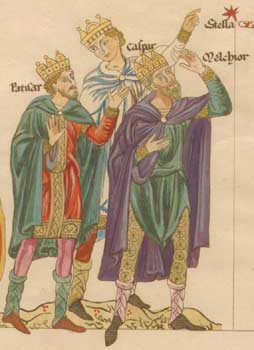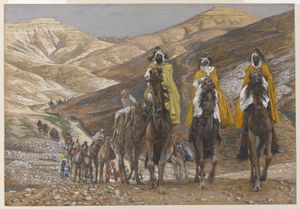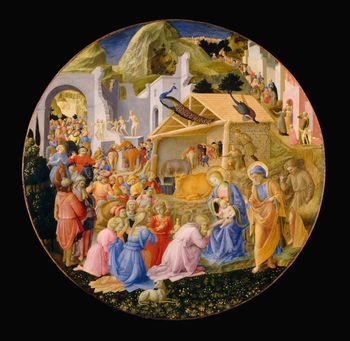مجوس الإنجيل

بازيليكا سانت أپوليناره الجديدة، راڤـِنا، إيطاليا – مرممة في القرن الثامن عشر.
| أحداث في |
| حياة يسوع حسب الأناجيل |
|---|
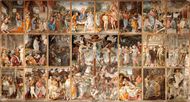 |
|
بوابات: |
المجوس Magi (/ˈmædʒaɪ/[1] أو /ˈmeɪdʒaɪ/؛ باليونانية: μάγοι, magoi)، كما يشار إليهم بلقب الحكماء (الثلاثة) أو الملوك (الثلاثة) كانوا، في إنجيل متى والتراث المسيحي، مجموعة من الأجانب البارزين زاروا يسوع بـُعـَيد مولده، حاملين هدايا من الذهب والبخور والمر. وهم شخصيات معتادة في الروايات التقليدية لاحتفالات ميلاد المسيح في عيد الميلاد كما يشكلون جزءاً هاماً من التقليد المسيحي.
وحسب متى، أحد الأناجيل الشرعية الأربعة، الذي يذكر المجوس، فقد جاؤوا "من الشرق" ليعبدوا "ملك اليهود".[2] وبالرغم من أن الرواية لا تذكر عدد الأشخاص "فإنهم" أو "المجوس" تشير إلى، الهدايا الثلاث مما قاد إلى الافتراض على نطاق واسع أنهم كانوا ثلاثة رجال.[3] في المسيحية الشرقية، وخصوصاً الكنائس السريانية، المجوس كثيرا ما يُذكر أن عددهم كان اثني عشر.[4] وصفهم كملوك في الكتابات المسيحية اللاحقة ربما ارتبط بالمزامير 72:11، "عسى أن يخر الملوك جميعاً سـُجـَّداً أمامه".[5][6]
أسماؤهم
لا يعطي الإنجيل أسماء المجوس، إلا أن الروايات والأساطير تذكر تشكيلة من الأسماء لهم.[7] ففي الكنيسة المسيحية الغربية فإنهم يُعتبرون جميعاً قديسون ويشيع معرفتهم بالأسماء التالية:
- ملكيور (/ˈmɛlkiˌɔːr/;[8] وأيضاً مليكيور[9])، دارس فارسي؛
- كاسپر (/ˈkæspər/ أو /ˈkæspɑːr/؛[10] وأيضاً كاسپار، گاسپر، جاسپر، جاسپاس، گاثاسپا،[9][11] وتنويعات أخرى)، دارس هندي؛
- بلتزار (/ˈbælθəˌzɑːr/ أو /bælˈθæzər/;[12] وأيضاً بلتسار، بالتازار، و بيثيساريا[9])، باحث بابلي.
بلدهم ورحلتهم
تعبيرهم عن التبجيل
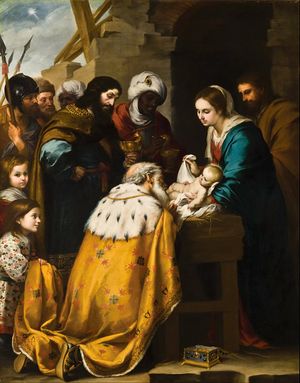
هداياهم
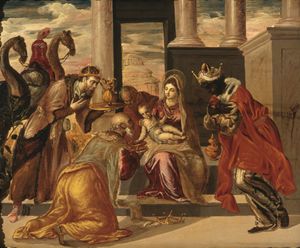 تبجيل المجوس بريشة إل گريكو، 1568 |
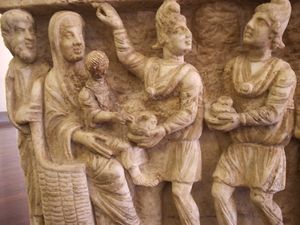 أحد أقدم التصويرات المعروفة للمجوس الثلاث على تابوت حجري من القرن الثالث. متاحف الڤاتيكان، روما، إيطاليا. |
ويقول يوحنا ذهبي الفم أن الهدايا التي قدموها لم تكن فقط تليق بأن تُقدم إلى ملك، بل تليق بأن تُقدّم إلى الرب، وقارن ذلك بأضحية اليهود التقليدية من خراف وعجول، وحسب خريسوستوم فإن المجوس الثلاثة كانوا يعبدون المسيح الوليد.
رواية استشهادهم
Christian Scriptures record nothing about the Biblical Magi after reporting their going back to their own country. Two separate traditions have surfaced claiming that they were so moved by their encounter with Jesus that they either became Christians on their own or were quick to convert fully upon later encountering an Apostle of Jesus. The traditions claim that they were so strong in their beliefs that they willingly embraced martyrdom.
رفاتهم في كولونيا
قبورهم
There are several traditions on where the remains of the Magi are located, although none of the traditions is considered as an established fact or even as particularly likely by secular history.
زعم ماركو پولو أنه رأى القبور الثلاثة للمجوس في ساوه جنوب طهران في عقد 1270:
في بلاد فارس تقع مدينة Saba, from which the Three Magi set out and in this city they are buried, in three very large and beautiful monuments, side by side. And above them there is a square building, beautifully kept. The bodies are still entire, with hair and beard remaining.
— Marco Polo، Polo, Marco, The Book of the Million, book i.
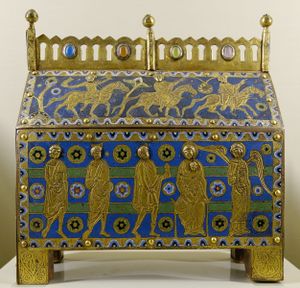
الأهمية الدينية
التقاليد
التقاليد الاسبانية
وسط اوروبا


في الفن
في الفنون الأخرى
المسرح
- تمثيل للمجوس في أوپرا جان كارلو منوتي أمال وزوار الليل، وفي العديد من ترانيم الميلاد، ومن أفضل نسخها بالإنگليزية "نحن الملوك الثلاث We Three Kings".
انظر أيضاً
- الفلك
- Christian views on astrology
- List of names for the biblical nameless
- Mystery play
- القديس كاسپر
- القديس نيقولا
- Simon Magus
الهامش
- ^ Holman Illustrated Bible Dictionary. Nashville, Tennessee: Holman Bible Publishers. 2003. p. 1066. ISBN 0-8054-2836-4.
- ^ Matthew 2:1-2
- ^ Geza Vermes, The Nativity: History and Legend, London, Penguin, 2006, p. 22
- ^ Metzger, 24 [80]
- ^ "Magi". Encyclopedia Britannica.
- ^ s.v. magi (Third ed.). April 1910.
- ^ See Metzger, 23–29 for a lengthy account
- ^ "Melchior". Collins Dictionary. n.d. Retrieved 25 September 2014.
- ^ أ ب ت خطأ استشهاد: وسم
<ref>غير صحيح؛ لا نص تم توفيره للمراجع المسماةexbar - ^ "Caspar or Gaspar". Collins Dictionary. n.d. Retrieved 25 September 2014.
- ^ Hugo Kehrer (1908), Vol. I, p. 70 Online version Kehrer's commentary: "Die Form Jaspar stammt aus Frankreich. Sie findet sich im niederrheinisch-kölnischen Dialekt und im Englischen. Note: O. Baist page 455; J.P.Migne; Dictionnaire des apocryphes, Paris 1856, vol I, p. 1023. ... So in La Vie de St. Gilles; Li Roumans de Berte: Melcior, Jaspar, Baltazar; Rymbybel des Jakob von Märlant: Balthasar, Melchyor, Jaspas; ein altenglisches Gedicht des dreizehnten oder vierzehnten Jahrhunderts (13th century!!) Note: C.Horstmann, Altenglische Legenden, Paderborn 1875, p. 95; ... La Vie des trois Roys Jaspar Melchior et Balthasar, Paris 1498"-->]
- ^ "Balthazar". Collins Dictionary. n.d. Retrieved 25 September 2014.
المراجع
- Giffords, Gloria Fraser, Sanctuaries of Earth, Stone, and Light: The Churches of Northern New Spain, 1530–1821, 2007, University of Arizona Press, ISBN 0816525897, 9780816525898, google books
- Metzger, Bruce, New Testament Studies: Philological, Versional, and Patristic, Volume 10, 1980, BRILL, ISBN 9004061630, 9789004061637, google books
- Penny, Nicholas, National Gallery Catalogues (new series): The Sixteenth Century Italian Paintings, Volume II, Venice 1540–1600, 2008, National Gallery Publications Ltd, ISBN 1857099133
- Schiller, Gertud, Iconography of Christian Art, Vol. I, 1971 (English trans from German), Lund Humphries, London, ISBN 0853312702
للاستزادة
- Albright, W. F. and C. S. Mann. "Matthew." The Anchor Bible Series. New York: Doubleday & Company, 1971.
- Becker, Alfred: Franks Casket. Zu den Bildern und Inschriften des Runenkästchens von Auzon (Regensburg, 1973) pp. 125–142, Ikonographie der Magierbilder, Inschriften.
- Benecke, P. V. M. (1900). "Magi". In James Hastings (ed.). A Dictionary of the Bible. Vol. III. pp. 203–206.
{{cite encyclopedia}}: Cite has empty unknown parameters:|month=and|coauthors=(help) - Brown, Raymond E. The Birth of the Messiah: A Commentary on the Infancy Narratives in Matthew and Luke. London: G. Chapman, 1977.
- Clarke, Howard W. The Gospel of Matthew and its Readers: A Historical Introduction to the First Gospel. Bloomington.
- Chrysostom, John "Homilies on Matthew: Homily VI". c. 4th century.
- France, R. T. The Gospel According to Matthew: an Introduction and Commentary. Leicester: Inter-Varsity, 1985.
- Gundry, Robert H. Matthew a Commentary on his Literary and Theological Art. Grand Rapids: William B. Eerdmans Publishing Company, 1982.
- Hill, David. The Gospel of Matthew. Grand Rapids: Eerdmans, 1981
- Lambert, John Chisholm, A Dictionary of Christ and the Gospels. Page 97 – 101.
- Levine, Amy-Jill. "Matthew." Women's Bible Commentary. Carol A. Newsom and Sharon H. Ringe, eds. Louisville: Westminster John Knox Press, 1998.
- Molnar, Michael R., The Star of Bethlehem: The Legacy of the Magi. Rutgers University Press, 1999. 187 pages. ISBN 0-8135-2701-5
- Powell, Mark Allan. "The Magi as Wise Men: Re-examining a Basic Supposition." New Testament Studies. Vol. 46, 2000.
- Schweizer, Eduard. The Good News According to Matthew. Atlanta: John Knox Press, 1975.
- Trexler, Richard C. Journey of the Magi: Meanings in History of a Christian Story. Princeton University Press, 1997.
- Watson, Richard, A Biblical and Theological Dictionary, Page 608–611.
- Hegedus, Tim (2003). "The Magi and the Star in the Gospel of Matthew and Early Christian Tradition". Laval théologique et philosophique. 59 (1): 81–95. doi:10.7202/000790ar.
وصلات خارجية
- Mark Rose, "The Three Kings & the Star": the Cologne reliquary and the BBC popular documentary
- Alfred Becker, Franks Casket
- Caroline Stone, "We Three Kings of Orient Were"
- Magi Catholic Encyclopedia
- "Procession of the Three Kings in Valencia"
- Auto de los Reyes Magos (drama in Spanish)
تبجيل الحكماء
| ||
| سبقه نجم بيت لحم |
أحداث الإنجيل |
تبعه الهرب إلى مصر |
